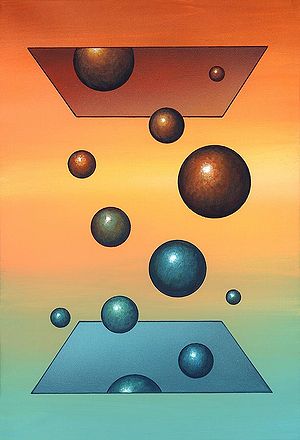First Law of Thermodynamics: Difference between revisions
| Line 15: | Line 15: | ||
==Examples== | ==Examples== | ||
===Energy | ===Solving for Change in Internal Energy=== | ||
If 500J of work is done on a system, and it gains 100 J of heat from its surroundings, then what is the change in internal energy of the system? | |||
==Connectedness== | ==Connectedness== | ||
Revision as of 03:56, 19 April 2016

Thermodynamics is concerned with energy change and how heat, temperature, energy, and work are correlated.
The Main Idea
The First Law of Thermodynamics states that all thermodynamic systems have a property called energy, and that energy can be neither created nor destroyed. Even if the energy cannot be created or destroyed, power generation process and energy sources help the conversion of the energy from one form to an another.
A Mathematical Model
[math]\displaystyle{ ∆U = Q-W }[/math] where [math]\displaystyle{ ∆U }[/math] is change in the internal energy , [math]\displaystyle{ Q }[/math] is heat added to the system, and [math]\displaystyle{ W }[/math] is the work done by the system. In other words, change in internal energy is equal to flow of heat into a system minus work done on the system. While both [math]\displaystyle{ Q }[/math] and [math]\displaystyle{ W }[/math] are path functions, [math]\displaystyle{ ∆U }[/math] is a path-independent state function, which means that it only depends on the current state of the system.
A Computational Model
How do we visualize or predict using this topic. Consider embedding some vpython code here Teach hands-on with GlowScript
Examples
Solving for Change in Internal Energy
If 500J of work is done on a system, and it gains 100 J of heat from its surroundings, then what is the change in internal energy of the system?
Connectedness
- How is this topic connected to something that you are interested in?
T
- How is it connected to your major?
- Is there an interesting industrial application?
History
The First Law of Thermodynamics, in its current state, was first explicitly expressed by Clausius in 1850. In his Mechanical Theory of Heat, he stated that "in a thermodynamic process involving a closed system, the increment in the internal energy is equal to the difference between the heat accumulated by the system and the work done by it."
See also
Are there related topics or categories in this wiki resource for the curious reader to explore? How does this topic fit into that context?
Further reading
- Thermodynamics (Dover Book on Physics) by Enrico Fermi
- Engineering Thermodynamics by P. K. Nag
- M. J. Moran and H. N. Shapiro, ‘Fundamentals of Engineering Thermodynamics’, Fourth Edition, Wiley, New York, 2000
- Thermodynamics: An Engineering Approach by Cengel, Ya and Boles, M.A.
External links
- http://www.scientificamerican.com/article/bring-science-home-reaction-time/
- http://www.physlink.com/Education/AskExperts/ae280.cfm
- http://web.mit.edu/16.unified/www/FALL/thermodynamics/notes/node15.html
- http://hyperphysics.phy-astr.gsu.edu/hbase/thermo/firlaw.html
- ThermoNet
References
- Callen, Herbert B. (1985). Thermodynamics and an Introduction to Thermostatistics. Wiley. p. 5,37.
- http://fineartamerica.com/featured/1-thermodynamics-conceptual-artwork-richard-bizley.html
- http://www.humanthermodynamics.com/Clausius.html
- http://web.mit.edu/16.unified/www/FALL/thermodynamics/notes/node15.html